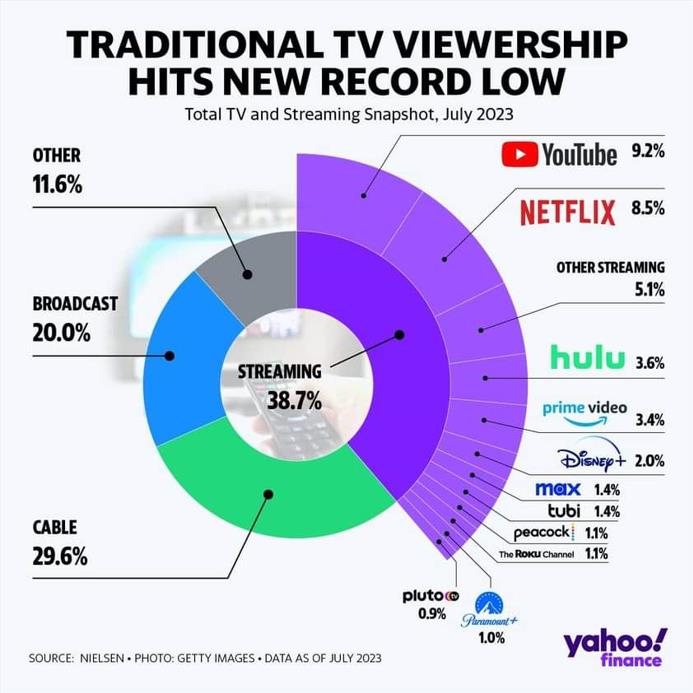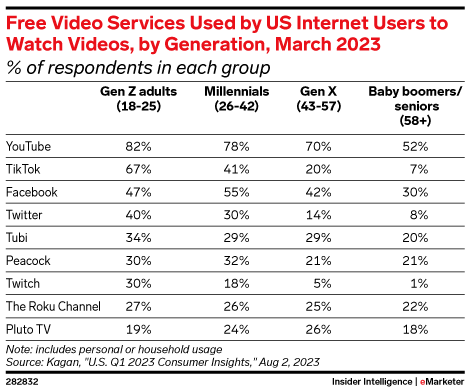Gone are the days of Mad Men, when the “big three” television networks reigned supreme as the best way to reach consumers. These days, outdoor recreation and attraction consumers are more likely to tune into their favorite streaming service and viewership of linear TV (made up of both broadcast and cable viewing) has continued to decline.
This year, for the first time, linear TV viewing hit an all time low, making up 49.6% of video-viewing audiences. The gap is filled by various streaming services, including free (ad-supported) services and paid subscriptions. Consumers of both outdoor recreation products and services and attractions are diverse and it is essential to understand what media channels customers are using in order to maximize outdoor recreation marketing plans and understand current attraction trends.
Cord-Cutting Trend Continues to Rise
Streaming companies offer compelling advantages over traditional cable and satellite packages, particularly appealing to younger audiences. They are generally more affordable, offer more flexibility with starting and stopping services and they are rapidly expanding their content libraries, offering more incentives for viewers to “cut the cord”.
To further complicate the landscape, particularly for outdoor recreation marketing, the migration of major sports content from linear television to streaming platforms is expected to further drive cord-cutting. According to Intelligence Insider’s forecast, the “time spent” gap between digital streaming viewing compared to traditional TV will widen over the next few years from 28 minutes in 2023 to over an hour in 2025, meaning time is of an essence to ensure other video options are part of outdoor recreation and attraction media plans.

These Shifts Bring Challenges
While these changes benefit consumers by offering less expensive options, a wider variety of content, and greater choices overall, they present challenges for marketers seeking to deliver their messages effectively. During the Golden Age of Television, marketers could reach over 90% of the population by running their commercials in the evening news. In 2023, the abundance of streaming platforms has changed how consumers view content and it is much harder to “find” your customer in one place. There are so many media options and outdoor/ travel content available, it is more difficult to advertise to the right people.
Besides the number of options for consumers to choose from when it comes to streaming, the adoption of streaming services also continues to be a challenge, with younger audiences gravitating towards streaming, while older audiences are more likely to still be watching liner television. The landscape is evolving as older demographics are beginning to embrace streaming technologies, making it essential for marketers to adapt and connect with their audiences on streaming platforms. This also can be an expensive prospect for your advertising plans if your outdoor recreation product or attraction reaches both an older and younger audience.

How Do You Know Where to Advertise?
It is now more critical than ever for marketers to understand their audience and their media habits, as well as outdoor recreation and attraction trends. Most advertisers do not have unlimited marketing budgets, making it essential to ensure that advertising reaches the right audience at the right place. To find the sweet spot for your audience, consider these strategies:
- Do Your Research: While not every marketer has access to expensive research tools, creative approaches can yield valuable insights. Partnering with agencies that specialize in audience analysis is one option, but marketers can also employ surveys, industry trend analysis, and tracking to identify shifting audience preferences and outdoor recreation and attraction trends.
- Know Your Competition: Keep a close eye on your competitors to understand their attraction and outdoor recreation marketing strategies and media spend. This can provide valuable insights into where to allocate your budget effectively. Leveraging both sophisticated tools and grassroots research can give you a competitive edge.
- Test Things Out: Experimentation is key. Run small, targeted campaigns with clear calls-to-action to gauge audience response across various media channels. This approach allows you to fine-tune your strategies and identify what resonates with your customers.
- Fund Marketing Appropriately: While it may be tempting to try every available platform, it’s crucial to allocate your budget wisely. Focus on what works best for your specific audience and drives the most significant results. Spreading your budget too thin can dilute the impact of your attraction and outdoor recreation marketing efforts.
Conclusion
In conclusion, the landscape of television and media consumption has undergone a seismic shift, ushering in the era of streaming dominance and the gradual decline of linear TV. This transformation, driven by factors such as affordability, flexibility, and an ever-expanding content library, has fundamentally changed the way audiences engage with content. Within the outdoor recreation and attraction industries, the audience is diverse, meaning it is even harder to find the best media channels. As a result, marketers face new challenges in reaching their target audiences effectively.
The days when a single evening news broadcast could reach over 90% of the population are long gone. Instead, consumers now have a plethora of streaming options, making it harder for attraction and outdoor recreation marketers to pinpoint where their audience spends their time. Nevertheless, by embracing change, conducting thorough research, monitoring competitors, experimenting with different channels, and budgeting effectively, marketers can continue to connect with their audience in this new age of streaming.










